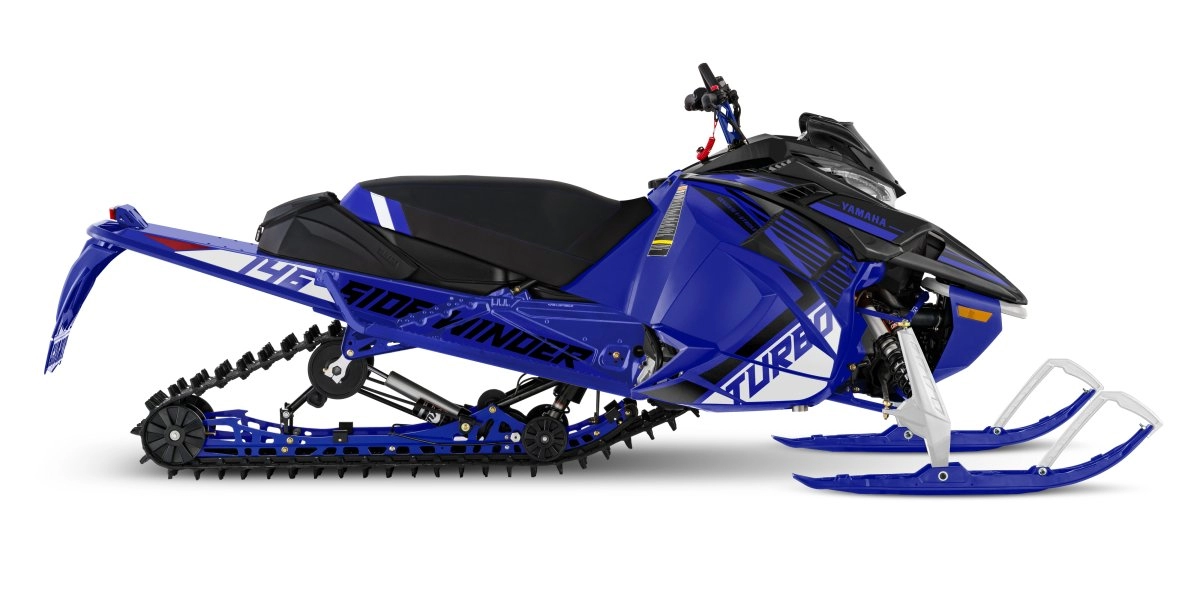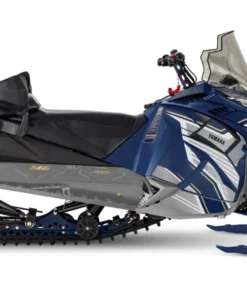KEY FEATURES
Lightweight with a tall and narrow profile, the X-TX mountain seat is both shorter and more tapered towards the front than our standard trail seat. This allows for easier rider transitions from side-to-side, and improved stand-up ergonomics. Included in-seat electric heat element for additional comfort in the cold and wet.
The Sidewinder’s generous 8.9-gallon / 33.6-liter fuel tank serves more purposes than just carrying a day’s worth of fuel. It also cradles the battery and is the platform for the quick-release trail seat. The ever-changing fuel load is carried low and rearward, helping centralize the overall mass and balance of the sled.
The handlebar controls feature a left-hand switch cluster which allows for ‘on-the-fly’ access to the multi-step hand and thumb warmer adjusters. Information available on the multi-function gauge can be easily selected with a convenient toggle switch and the push button electric start, reverse gear switch is also located in the left-hand cluster. The right side of the bar is clean with an ergonomically shaped throttle lever and simple, stand-alone emergency stop switch. The Hayes ‘Stealth’ brake cylinder is equipped with a composite brake lever providing great modulation for better feel and powerful stopping performance.
Additional storage is provided by a convenient under-seat bag. The semi-rigid design is easy to access and water resistant to keep your spares safe and dry. Quarter-turn, quick release fasteners are provided to make removal a snap.
Convenient handlebar positioning makes shifting to and from reverse easy with just the push of your thumb. A servo motor shifts the drivetrain into reverse simply and consistently. An audible warning beeper reminds you when you are still in reverse.
Handling
The Yamaha designed single keel ski strikes the elusive balance between lightweight steering effort and precision handling over a wide range of snow conditions. Special carbides further enhance steering response. A unique shim pad assembly works in conjunction with the rubber saddle block to adjust the carbide pressure point. Overall ski stance is also adjustable by relocating the thick spacer located on each ski axle to the opposite side.
A dedicated, tall steering post delivers optimum ergonomics for standup riding. The 5.5-inch riser with broad, molded, curved-end mountain bar and incorporated mountain strap delivers ample leverage for off-trail riding. The system is adjustable to dial in sweep and reach to help keep you in the sweet spot.
The full-width ski stance applied to the LE is targeted towards aggressive corner speeds with flat handling characteristics.
The SRV chassis combines a load-bearing triangulated structure with lightweight aluminum construction to create a neutrally balanced sled that’s centered on the rider. The pyramidal upper frame creates chassis strength without excessive weight.
The SRV chassis layout was engineered with the goal of centralizing mass. Approximately 60 percent of the sled’s weight is tightly centered within the main triangulation. The result is a quick-handling, well-balanced sled that’s fun to throw around in a wide variety of conditions.
Performance
Yamaha engineers wanted an engine that’s exceptionally quick to respond with little or no ‘lag’ as found in a conventional turbo. One of the ways they achieved their goal was to develop an intake system using three separate throttle bodies positioned very close to the intake valves, instead of just one feeding long intake tubes. It’s an innovation not seen in any other production turbo on the planet, and another first for Yamaha with the Genesis turbo.
A dual-piston brake caliper applies braking forces directly to the drive shaft and is mated to a wave-style, lightweight drilled rotor. The LE-only rotor removes one pound of rotating mass from the vehicle’s driveline, helping transfer all of the Sidewinder’s available horsepower to the snow. The ‘Stealth’ master cylinder and composite ‘Stealth’ brake lever offer excellent modulation and feel with ergonomically precise operation.
The YSRC primary and roller secondary clutches are calibrated for durable, cool operation. They harness and transfer the massive torque produced by the Genesis Turbo efficiently to the track while minimizing drive belt wear. The primary shifts out aggressively to use all the power on tap while the roller secondary is quick to back-shift and provides additional ratio through its oversize sheaves to keep accelerating long after the others have signed off.
Engine coolant is circulated through the turbocharger to control both under-hood temperature and help cool the intake charge. Upon engine shut down, the convection energy produced by super-heated coolant at the turbo head keeps it circulating without the coolant pump in operation. This eliminates the need for an engine cool down cycle while maintaining high durability in the turbo components.
Unlike conventional turbo ‘blow-off’ valves, the Yamaha ABV redirects air pressure back into the intake side of the compressor to prevent surge and help maintain impeller speed, resulting in ready acceleration and seamless power delivery.
The Yamaha-developed Mitsubishi ECU uses a series of nine sensors to gather running condition data which it computes using a predetermined memory ‘map’. It then adjusts ignition timing, fuel delivery, manifold air pressure and turbo boost pressure to produce maximum performance under any condition—reliably.
The nickel alloy turbine body is extremely strong and precise, able to withstand highly elevated temperatures. Supported by premium, ceramic ball bearings the Inconel turbine blade assembly is very light and strong. This yields a low moment of inertia for lightning quick response to exhaust gas input. Triple throttle bodies are used exclusively to further enhance the quick delivery of compressed air from the impeller to intake valves.
Top Features
Mountain Steering System
A dedicated, tall steering post delivers optimum ergonomics for standup riding. The 5.5-inch riser with broad, molded, curved-end mountain bar and incorporated mountain strap delivers ample leverage for off-trail riding. The system is adjustable to dial in sweep and reach to help keep you in the sweet spot.
Premium Fox 1.5 Zero iQS Suspension
The Sidewinder X-TX LE front suspension is equipped with Fox Zero iQS shocks providing a premium upgrade to this model.
Versattack 146 ‘Uncoupled’ Rear Suspension
The dual-shock 146 rear suspension is fitted into a light mountain, tapered tunnel. It also features a mountain style front arm with special 146-inch rails that utilize a long rear QS3 iQS shock and lightweight single pull rod. A specially designed shock pivot is added to the uncoupled front arm to provide smooth weight transfer for great handling traction both in and out of the powder.
SPECIFICATIONS
ENGINE
| Engine Type | Turbo 4-Stroke / 998 cc |
| Engine Class | Ultra Performance |
| Fuel Delivery | Electronic Fuel Injection |
| Fuel Capacity | 8.9 gal. (33.6 L) |
SUSPENSION
| Suspension/Front | Independent Double Wishbone |
| Front Shocks | Fox 1.5 Zero iQS |
| Front Travel | 10″ (254 mm) |
| Front Shocks | Yamaha Stryke Single Keel |
| Suspension/Rear | Uncoupled Versattak 146 |
| Center Shock | Monotube Alum-HP GAS 1.5 |
| Rear Shock(s) | Fox Zero 2.0 iQS |
| Rear Travel | 13.5″ (343 mm) |
DIMENSIONS
| Track / W x L x H | 15″ x 146″ x 1.60″ |
| Ski Stance | 42″ (1,067 mm) adjustable |
| Fuel Capacity |
8.9 gal. (33.6 L)
|
Only logged in customers who have purchased this product may leave a review.
Related products
SNOWMOBILES
SNOWMOBILES
SNOWMOBILES
SNOWMOBILES
SNOWMOBILES
SNOWMOBILES
SNOWMOBILES
SNOWMOBILES












Reviews
There are no reviews yet.